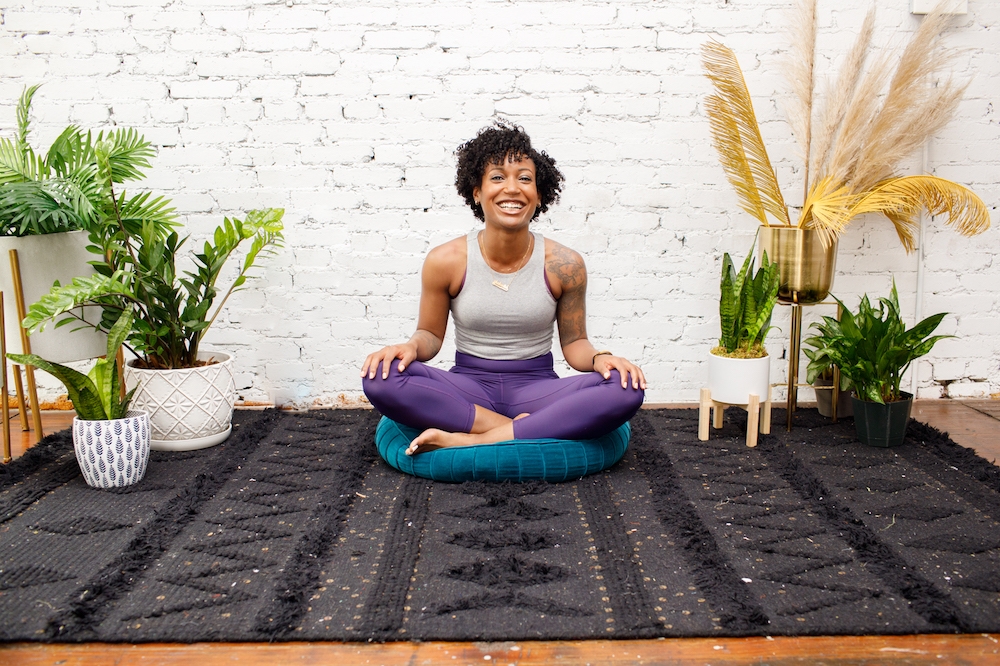Life
 Shakeelah Sutton. Photo courtesy of subject.
Shakeelah Sutton. Photo courtesy of subject.
D.C. Yoga Teacher + Exercise Physiologist Shakeelah Sutton on Holistic Self-Care
March 12, 2021 @ 12:30pm
Exercise physiologist and yoga teacher Shakeelah Sutton channeled her experiences with yoga and holistic healing into the calm/cool collective. The collective provides holistic health tips and wellness resources to BIPOC (Black, Indigenous, and people of color) communities to use when handling stress and trauma. Sutton talked to us about how physical and mental well-being are intertwined and the importance of self-care in times of stress. Note: This interview is a part of our 20 Masters of Mindfulness, Movement + Connection roundup, which ran in our Winter 2021 issue.
Tell me about your journey and how it brought you to your current role.
My current role sits at the intersection of my personal wellness journey, trauma healing and professional career. I’ve always been passionate about health equity, especially among black and brown communities. Growing up in southern California, I saw first-hand the effects poverty, limited food access and sedentary lifestyles had on the health of my family members. Inspired by my great aunt Olevia who suffered from diabetes, I became an exercise physiologist to help BIPOC (Black, Indigenous and people of color) manage and prevent chronic diseases. A few years later, I was suddenly diagnosed with undifferentiated connective tissue disease, an inflammatory autoimmune condition that causes severe pain in my muscles and joints. I went from high intensity two-a-days to crawling on my apartment floor because it hurt too much to stand. My mind became obsessed with my body’s inability to move, pulling me into a depressive spiral that ran on a feedback loop along with the pain. Then, yoga.
I began practicing yoga for the sole purpose of loosening stiff joints, but the more I practiced, the more I understood that it wasn’t about manipulating my body to get into a pose, but rather using the poses to get into my body. It’s a chance to come home to myself by paying full attention to how I feel in the moment without labeling it as good or bad. Once I learned how to observe my body in this way, I naturally became more aware of my mind and the quality of my thoughts and emotions. Over time I began using yoga, meditation and other mindfulness practices to acknowledge and heal from decades of pain and generational trauma that I’d been internalizing since childhood.
In 2017 I joined MedStar Georgetown University Hospital to develop and implement FITNESS, a healthy weight management program, to DC Public Schools. Realizing the difficulty in impacting children’s physical health without also addressing their social-emotional health, I became a certified yoga teacher and created a supplemental youth yoga and mindfulness program that reached over 700 students in the district.
Over the years, I’ve shifted from improving the physical health of BIPOC communities to taking a more holistic approach to well-being. Many of our life experiences warrant the need for yoga and other healing practices, yet the lack of representation and inclusion in many of these spaces give the impression that they aren’t for us. Last fall I launched the calm/cool collective, a wellness community that offers healing through holistic wellness practices, mindfulness tools and resources for BIPOC facing stress and trauma from their lived experiences. It’s a space for us to strengthen self-awareness, resiliency and the ability to feel at ease in any given moment.
How are you practicing and prioritizing self-care, especially mid-pandemic?
When the city shut down last March I immediately began exploring different ways to practice self-care. Having regular check-ins with myself to notice how I’m feeling and what I need in any given moment became the foundation of my self-care practice. I often don’t realize I’m stressed or anxious until it shows up in my body (i.e. insomnia, stomach issues, hair loss) so developing that self-awareness was key in learning how to meet my physical, mental and emotional needs during this period of chronic stress. When my mother passed away unexpectedly in October, grief and despair compounded the already stressful situation and at that point self-care became a necessary tool for survival. Currently my self-care practices include exercising three times a week, maintaining a regular sleep schedule, and soothing my nervous system with breathwork and restorative yoga.
What does self-compassion mean to you, and how do you incorporate it into your practice?
Self-compassion is being the best friend you’ve always needed, but to yourself. It’s telling your inner critic to chill with the judgements and instead offer yourself kindness and empathy for how you’re feeling at the moment. As someone who inherently feels the need to always be “strong” and “put together” (both of which are trauma responses from childhood), I struggled with allowing myself to feel and process the influx of emotions I experienced after my mom died. I’ve since learned that acknowledging and validating my feelings on a daily basis is the first step in releasing resistance and allowing the energy of the emotions to flow freely. I also give myself permission to take breaks and rest when I need to, and remind myself that I’m doing the best that I can.
Learn more at calmcool.co and follow @calmcoolco and @cool_shak on Instagram.
Enjoy this piece? Consider becoming a member for access to our premium digital content. Support local journalism and start your membership today.







